Resume Templates
Resume samples
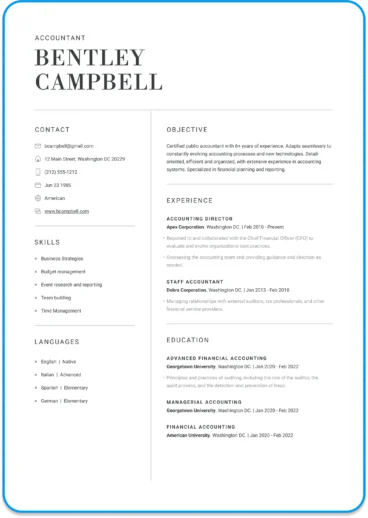
Create and edit your resume online
Generate compelling resumes with our AI resume builder and secure employment quickly.
Write a cover letter

Take a look at our cover letter guides and examples, to help you write a cover letter that complement your resume and enhace your applications.
Cover Letter Examples
Cover Letter Samples
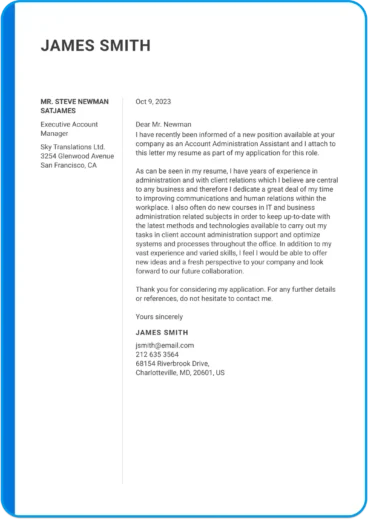
Create and edit your cover letter
Use our user-friendly tool to create the perfect cover letter.
Featured articles
- How to Write a Motivation Letter With Examples
- How To Write a Resume in 2025 That Gets Results
- Teamwork Skills on Your Resume: List and Examples
- What Are the Best Colors for Your Resume?
Latests articles
- 5 Things to Do When You Are Overqualified for a Job
- Silent Strengths: Top Jobs for Introverts
- Flexible and Rewarding Jobs for Moms: 2025’s Top Picks
- Mastering LinkedIn Skills – Tips, Tricks, and Best Practices
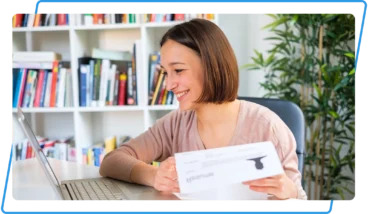
Dive Into Expert Guides to Enhance your Resume

The Ultimate Cover Letter Writing Guide
The complete guide to writing an effective cover letter.

Any of these sound familiar? The simple answer is yes, having an effective cover letter is completely necessary and highly recommended and we’ll tell you why you need a cover letter as well as a resume!
When you’re applying for a job, whether it be for an entry-level position after graduating or for a high-level executive vacancy with a professional resume , a cover letter is essential to make your application stand out .
Without this extra introductory letter, a resume alone could easily be discarded by a hiring manager. CareerBuilder estimates you’re 10% more likely to miss out on an opening if you don’t include a cover letter.
Writing a good cover letter it’s not a skill many many people master, but that doesn’t mean it’s an impossible feat!
With our complete cover letter guide , you’ll learn how to write a cover letter that will attract the hiring manager and convince them to read your winning resume.
What is a cover letter?
A cover letter is an extension to your job application. It is not obligatory but including a well-written cover letter is strongly advised by all human resource experts . By definition, a cover letter is an accompanying, explanatory letter.
All jobseekers need a sales pitch of sorts, they need to hook the reader and demonstrate to the hiring manager why they are the right person for the vacancy on offer. This style of self-marketing for a job application must come in the form of a winning resume and cover letter combination that complement one another.
A simple cover letter is an introduction to the candidate behind the qualifications and experience. The aim is to show a prospective employer how you can take on the role and what you can offer the company in question.
Cover letters generally follow a basic structure and can be in either hard or digital format, that is to say, either printed and sent via regular mail or as a document scanned and attached to send digitally, or written directly in an email cover letter .
Why include a cover letter on a job application?
If you want to stand any chance at all of catching the eye of a potential employer , it is imperative to include a cover letter with your job application.
Simple – even if you create an effective, outstanding resume , using all the right keywords and qualifications etc. it’s possible there are candidates more qualified than you or with more experience so it’s necessary to add a cover letter to back up your resume and allow the hiring manager to see more of your personal side that is relevant to the vacancy.
- The cover letter demonstrates your communication skills.
- The cover letter serves as an introduction to the resume.
- The cover letter can be used to emphasize certain skills, or mention skills that you couldn’t fit on the resume (it serves as an addendum).
- The cover letter is what you customize for each position, to show why you are the right person for “That” role, as opposed to the resume which stays pretty much the same for all applications.
A cover letter is the added value that you need in a job application to ensure the call-back you’ve been waiting for.
To create a unique, tailor-made job application , each candidate should use a cover letter to highlight their strengths and elaborate on relevant achievements that demonstrate their ability to take on the new responsibilities.
Is it practically always sensible and appropriate to write a cover letter to accompany a resume for a job application that should be customized for the role you’re applying to including any explanations of information that might be missing from the resume, such as employment gaps, traveling, periods of study etc.
The only time it is acceptable to not include a cover letter in your job application is if the job listing specifically requests that you do not.
Advantages of Writing a Cover Letter
A cover letter directly adds to the likelihood that you are called in for an interview and gives you a better chance of being hired .
If you’re successful in writing an effective cover letter , it will offer you the following advantages:
- Hiring managers will see your added effort
- Demonstrates you put in the time to learn about the company
- It will add a personal touch to your application
- It shows your enthusiasm for the opening
- Hiring managers will become acquainted with your best qualities
Knowing exactly what is in a cover letter will ensure that it gives you a major advantage over the other applicants.
What are the 3 Types of Cover Letters?
Adding a cover letter is almost always essential, but choosing the appropriate letter will also be key. Depending on the job post you are applying for, you will need to select the best type of letter to send along with your resume.
There are 3 types of cover letters that you can send to a hiring manager. The 3 types are:
- Application cover letters
- Letters of Interest
- Email Cover letters
The letter you write is influenced by whether you are going to apply for a job directly , citing a referral, or asking about vacancies that are not advertised.
Whatever the case may be, ensure that the cover letter is specific to the job vacancy . It’s always important to avoid making a generic cover letter for every single job you apply for.
So, what are the 3 types of cover letters you should consider sending to a job recruiter?
Application Cover Letter
This is your classic cover letter that you send to a hiring manager when you spot a company advertising a job opening. When you want to directly apply for a position, it is mandatory to send this, unless you are specifically asked not to.
Using this letter, you can mention why you want to work for a specific company and why you are the perfect candidate for the position.
Letter of Interest
Say you notice a company that you would really like to work for. It fits your sector, and you know it offers great benefits and good pay. However, you can’t find any openings that match your skill set.
If that’s the case, you don’t need to sit around and wait for the company to have a job vacancy. You can take action with a letter of interest. This type of cover letter states your interest in being employed by a company that isn’t currently advertising any vacancies.
This type of letter goes by a couple of other names, such as:
- Letter of intent
- Statement of interest
Of course, since there is no vacancy there is no role you can specifically mention, which is the major difference between a letter of intent and a traditional cover letter. Your objective will be to advertise yourself well enough that an employer will just have to interview you.
Email Cover Letters
Over the years, the job application process has shifted to a nearly 100% online hiring process . Due to this, it may be necessary to send your cover letter in an email as part of your job application.
While applying, there may not be an option to upload your cover letter. Or maybe you would just like to send it in the body of your email along with your resume . You can send it in one of two ways, in the body of your email or as an attachment (in PDF).
How to write a cover letter
A cover letter, although short in length generally, can take time to elaborate as it is important to get it right. Sometimes, due to the scarce space for writing, candidates find it difficult to know what to include in a cover letter and what to leave out .
However, knowing how to do a cover letter can make all the difference to your job application and be the just the thing to capture the attention of a hiring manager.
A professional cover letter should be well-formatted, following a structure with a header, an opening paragraph, a second main paragraph, a final closing paragraph and a closing with signature/electronic signature.
To begin writing a cover letter for a job application , candidates should analyze their skills, qualifications, accomplishments and experience to decide which are the most fundamental aspects to include in their personalized cover letter.
Next, each jobseeker will have to select the most job-relevant of these elements to include by comparing them with the required or desired qualifications and experience in the job description.
Finally, the applicant should choose some memorable examples which demonstrate evidence of each element included in their cover letter, aiming to tell a story which shows their aptitude concerning each skill or qualification.
Jobseekers should also ensure to explore how to make a cover letter for their specific role or industry because, similarly to resumes, each cover letter should be tailored for the vacancy and company to which it will be sent.
It is vital for candidates to consider several factors when it comes to writing their professional cover letter . A jobseeker must review their resume work history section as well as any skills and honors included to find the most pertinent experiences that can be explored further. Detailing examples of when a candidate demonstrated certain abilities or expertise is how a candidate can convince a hiring.
One way to create a winning cover letter is to use an online cover letter creator or take advantage of cover letter templates as a stepping stone as well as checking out cover letter examples that can serve as a great source of inspiration for you to make your own unique cover letter .
Our cover letter builder forms part of our resume builder and allows jobseekers to create a more complete job application. Users can write their cover letter with pro tips and design help thanks to our pre-designed templates. Read our cover letter writing guide to get to grips with cover letter writing techniques and tips before using our online cover letter builder!
How to Structure a Cover Letter
The structure and layout of a cover letter is essential to make sure the letter displays each point that you wish to get across clearly and concisely . This means it’s necessary, in general, to follow a commonly-accepted format for an effective cover letter.
Similarly to a resume format , designing and writing a cover letter has certain rules which should be adhered to in order to convey the necessary information in a brief and to the point introductory letter.
Check out some of the cover letter best practices as advised by human resources experts below:
- It’s imperative to begin a cover letter with a header , including the candidate’s name and contact information as well as the date. This primary cover letter section can also include the job title, website and other relevant personal information.
Following this, the letter should include the details of the company and person to whom you are writing, with the full name, job title or team, company name and address.
- The main body of a cover letter should be divided into three sections : an introduction, a bullet list of accomplishments followed by a paragraph highlighting skills, and a closing paragraph inviting the hiring manager to contact you. By using bullet points when detailing your achievements and capabilities, you can make sure that recruiters will be able to quickly pick out key information. This is especially important as studies have found that recruiters spend very little time reading each individual application.
- Finally, the letter should be electronically or physically signed with your full name in a formal manner.
The universally-accepted cover letter length is no longer than one letter page, which in total has about 250-300 words for the main body of text.
Don’t repeat information or be too detailed because hiring managers simply do not have the time to read it all and will simply skip to the next one. Resumes that run over 600 words get rejected 43% faster and cover letters can easily fall into this trap too.
Keep your cover letter short and sweet and to the point!
Get more cover letter formatting advice in our guide on how to format a cover letter with tips and information about all aspects of a good cover letter structure.
Cover letter advice
The importance of including a cover letter with your job application is often overlooked by jobseekers of all categories, however this can seriously reduce your possibilities of getting an interview with a prospective employer.
Therefore you need not ask yourself when to write a cover letter because the answer is just that simple – it is always appropriate to include a cover letter in your job application , unless the listing explicitly requests that you do not.
Check out the following expert cover letter tips to create a winning cover letter that will convince the hiring manager to give you a call:
- We may be quite repetitive with this one but the sheer quantity of resumes and cover letters that are disregarded simply for forgetting this vital and basic rule is incredible: USE A PROFESSIONAL EMAIL ADDRESS for your contact details and that does not include your current work email but a personal, suitable email address.
- It is essential to remember to maintain your focus on the needs of the company you’re applying to and the requirements and desired abilities of the ideal candidate for the role. Do not focus on how you can benefit by becoming a member of their team, but on how the team can make the most of your experience and knowledge.
- Remember to highlight your transferable skills , especially in cases where you may not meet all the required qualities in the job description such as in student resumes and cover letters.
- Each cover letter for a job application, cover letters for internships , for further study or even volunteer experience should be tailored to their specific organization and position with the pertinent keywords.
- Use specific examples to demonstrate the candidate’s individual capacity to take on the role and tell a story with your cover letter to convey more of your personality and passion towards the sector or profession.
- Towards the end of a cover letter , each candidate should write a convincing finish to entice the hiring manager and in sales terminology “ seal the deal ”.
- Finally when you have completed your polished cover letter, potentially one of the most important steps in the process is to PROOFREAD . Candidates should request that a friend, mentor, teacher or peer takes a look at their cover letter for not only grammatical and spelling errors but also any unwanted repetition or unrelated information .
Some jobseekers doubt whether a cover letter is necessary or not , but as most human resource professionals agree without a well-written cover letter, candidates lose the possibility to demonstrate different aspects of their profile from those included in their resumes which could easily be the deciding factor in your application!
An easy and fast way to write an effective cover letter for a job application is to employ an online cover letter creator that will offer advice on how to complete a cover letter with examples and HR-approved templates.
Cover Letter FAQs
What do employers look for in a cover letter, can a cover letter be two pages, what is the difference between a cover letter and a resume, should you put a photo on a cover letter.
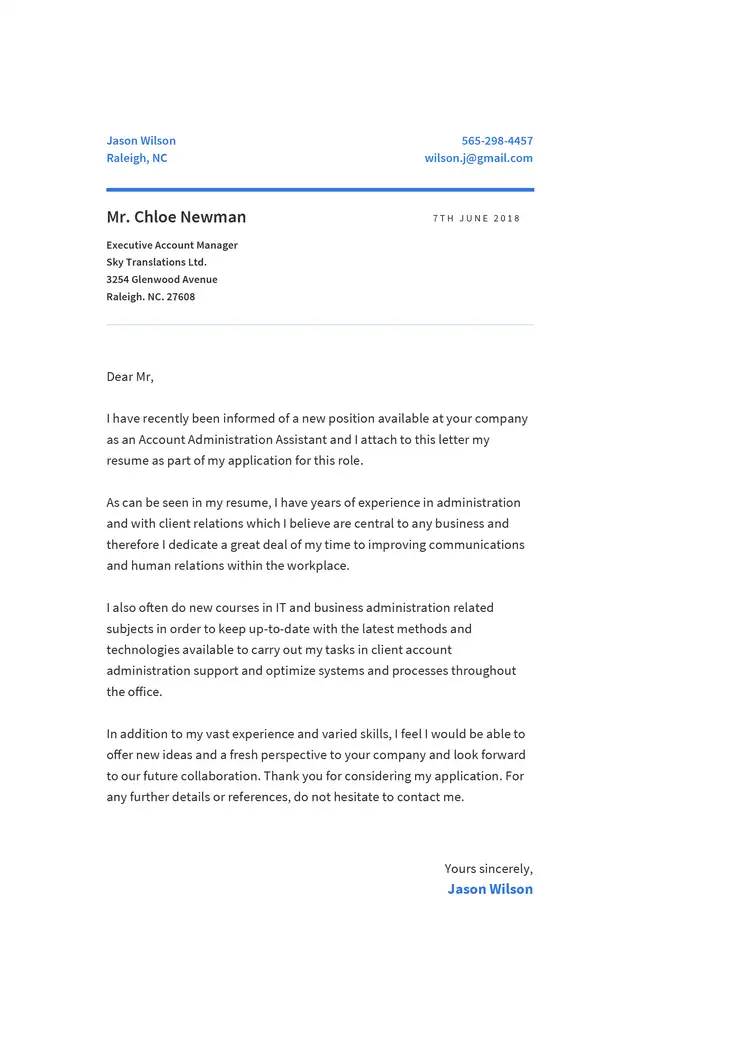
Trouble getting your Cover Letter started?
Beat the blank page with expert help.

Coach Cover Letter Example (Free Guide)
Create an coach cover letter that lands you the interview with our free examples and writing tips. use and customize our template and land an interview today..
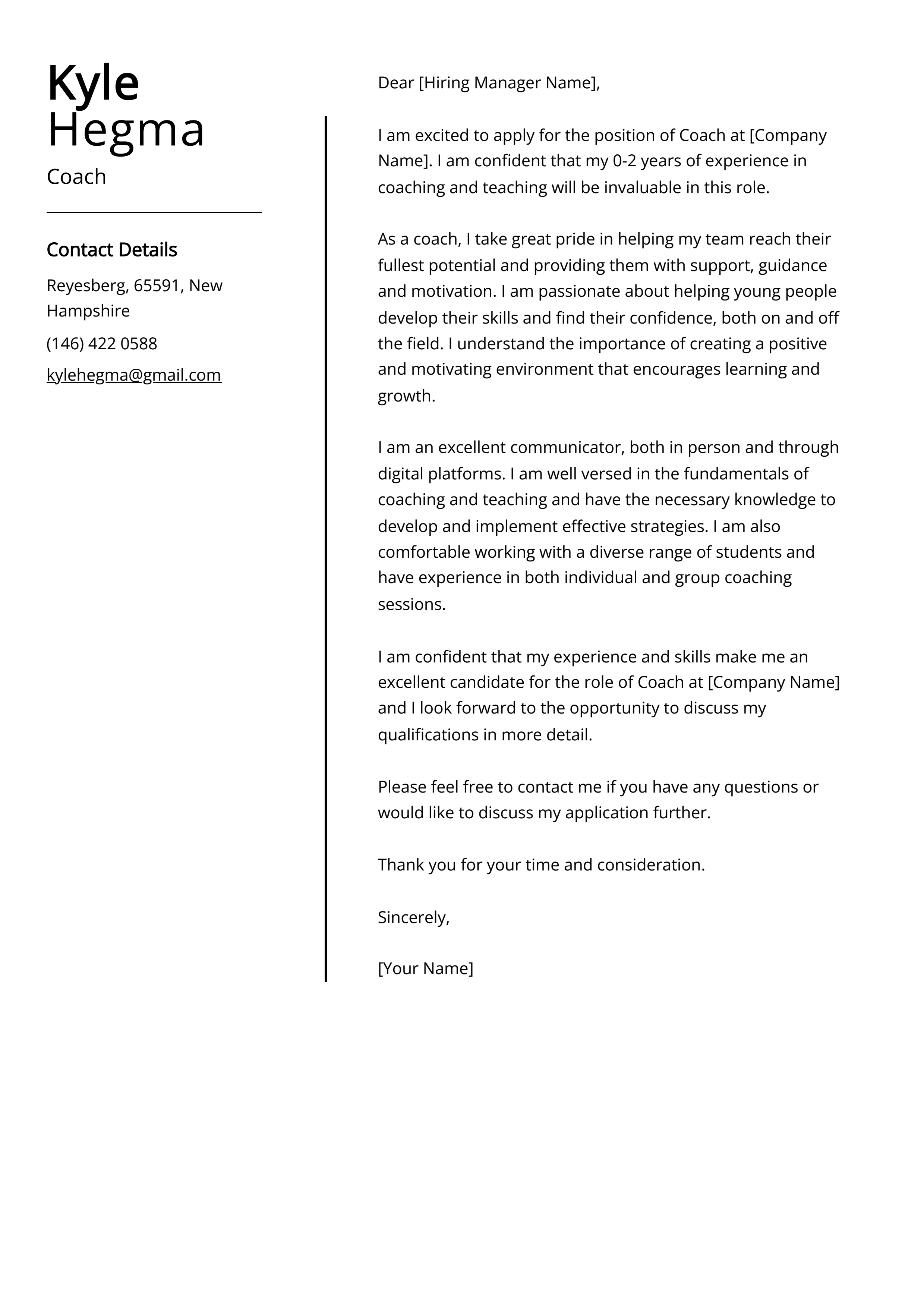
Are you looking for a new coaching job? Writing an effective cover letter is a key step in the job search process. Our coach cover letter guide will show you how to craft a winning cover letter that will impress potential employers and help you stand out from the competition. Follow our tips and you'll be on your way to landing your dream job.
We will cover:
- How to write a cover letter, no matter your industry or job title.
- What to put on a cover letter to stand out.
- The top skills employers from every industry want to see.
- How to build a cover letter fast with our professional Cover Letter Builder .
- What a cover letter template is, and why you should use it.

Related Cover Letter Examples
- Assistant Coach Cover Letter Sample
- Basketball Coach Cover Letter Sample
- Personal Fitness Trainer Cover Letter Sample
- Personal Trainer Cover Letter Sample
- Pilates Instructor Cover Letter Sample
- Soccer Coach Cover Letter Sample
- Swim Instructor Cover Letter Sample
- Yoga Instructor Cover Letter Sample
- School Teacher Cover Letter Sample
- Science Instructor Cover Letter Sample
- Secondary Teacher Cover Letter Sample
- Special Education Teacher Cover Letter Sample
- Teacher Assistant Cover Letter Sample
- Tutor Cover Letter Sample
- Vocational Counselor Cover Letter Sample
- High School Teacher Cover Letter Sample
- Infant Teacher Cover Letter Sample
- Instructor Cover Letter Sample
- Lecturer Cover Letter Sample
- Dance Teacher Cover Letter Sample
Coach Cover Letter Sample
Dear Coach,
I am writing to apply for the position of Coach at your organization. With my experience in sports and education, I am confident that I can be a valuable asset to your team.
I have been playing and coaching sports for over 20 years, having played football, basketball, and baseball at the high school level. I have also coached high school football and basketball teams, and I am currently an assistant coach for a travel baseball team. My experience has taught me the importance of team dynamics, communication, and strategy. I am also knowledgeable in various offensive and defensive strategies and can provide valuable insight to your team.
In addition to my sports experience, I have been teaching physical education for the past 10 years. I bring a wealth of knowledge of the fundamentals of various sports to the table, as well as an understanding of the physical and mental needs of athletes. I have a keen eye for identifying potential in athletes and am passionate about helping them to reach their full potential.
I also have experience in designing and implementing fitness programs for athletes of all ages and abilities. I am knowledgeable in the latest trends and techniques in fitness and am committed to helping athletes reach their desired goals.
I am highly motivated and enthusiastic about coaching and teaching, and I am confident that I can bring a unique and valuable perspective to your team. I am eager to discuss this position further and look forward to hearing from you.
Sincerely, [Your Name]
Why Do you Need a Coach Cover Letter?
A coach cover letter is an important part of the job application process. It is your opportunity to make a good first impression and show potential employers why you are the right person for the job. Here are a few reasons why you need a coach cover letter:
- It provides an opportunity to showcase your skills and experiences that are relevant to the coaching role.
- It gives you the chance to explain why you are the best person for the position.
- It allows you to highlight your achievements in the coaching field.
- It helps to show potential employers that you understand the position and what they are looking for in a coach.
- It provides an opportunity to demonstrate your enthusiasm and commitment to the role.
- It helps to express your personality and make a connection with the employer.
A Few Important Rules To Keep In Mind
- Address the letter to the specific person listed in the job posting.
- Start the letter with an introduction that states who you are and why you are writing.
- Include highlights of your coaching experience, such as years of experience, accomplishments, and any awards or certifications you have.
- Describe your coaching style and explain why it would be beneficial to the organization.
- Mention any special qualifications or skills that you possess that are relevant to the position.
- Include any volunteer or community service activities you have done related to coaching.
- Explain why you are interested in the position and why you are the best candidate for the job.
- End your letter with a short paragraph thanking the reader for their time and expressing your interest in the position.
- Proofread your letter for any spelling, grammar, or punctuation mistakes.
What's The Best Structure For Coach Cover Letters?
After creating an impressive Coach resume , the next step is crafting a compelling cover letter to accompany your job applications. It's essential to remember that your cover letter should maintain a formal tone and follow a recommended structure. But what exactly does this structure entail, and what key elements should be included in a Coach cover letter? Let's explore the guidelines and components that will make your cover letter stand out.
Key Components For Coach Cover Letters:
- Your contact information, including the date of writing
- The recipient's details, such as the company's name and the name of the addressee
- A professional greeting or salutation, like "Dear Mr. Levi,"
- An attention-grabbing opening statement to captivate the reader's interest
- A concise paragraph explaining why you are an excellent fit for the role
- Another paragraph highlighting why the position aligns with your career goals and aspirations
- A closing statement that reinforces your enthusiasm and suitability for the role
- A complimentary closing, such as "Regards" or "Sincerely," followed by your name
- An optional postscript (P.S.) to add a brief, impactful note or mention any additional relevant information.
Cover Letter Header
A header in a cover letter should typically include the following information:
- Your Full Name: Begin with your first and last name, written in a clear and legible format.
- Contact Information: Include your phone number, email address, and optionally, your mailing address. Providing multiple methods of contact ensures that the hiring manager can reach you easily.
- Date: Add the date on which you are writing the cover letter. This helps establish the timeline of your application.
It's important to place the header at the top of the cover letter, aligning it to the left or center of the page. This ensures that the reader can quickly identify your contact details and know when the cover letter was written.
Cover Letter Greeting / Salutation
A greeting in a cover letter should contain the following elements:
- Personalized Salutation: Address the hiring manager or the specific recipient of the cover letter by their name. If the name is not mentioned in the job posting or you are unsure about the recipient's name, it's acceptable to use a general salutation such as "Dear Hiring Manager" or "Dear [Company Name] Recruiting Team."
- Professional Tone: Maintain a formal and respectful tone throughout the greeting. Avoid using overly casual language or informal expressions.
- Correct Spelling and Title: Double-check the spelling of the recipient's name and ensure that you use the appropriate title (e.g., Mr., Ms., Dr., or Professor) if applicable. This shows attention to detail and professionalism.
For example, a suitable greeting could be "Dear Ms. Johnson," or "Dear Hiring Manager," depending on the information available. It's important to tailor the greeting to the specific recipient to create a personalized and professional tone for your cover letter.
Cover Letter Introduction
An introduction for a cover letter should capture the reader's attention and provide a brief overview of your background and interest in the position. Here's how an effective introduction should look:
- Opening Statement: Start with a strong opening sentence that immediately grabs the reader's attention. Consider mentioning your enthusiasm for the job opportunity or any specific aspect of the company or organization that sparked your interest.
- Brief Introduction: Provide a concise introduction of yourself and mention the specific position you are applying for. Include any relevant background information, such as your current role, educational background, or notable achievements that are directly related to the position.
- Connection to the Company: Demonstrate your knowledge of the company or organization and establish a connection between your skills and experiences with their mission, values, or industry. Showcasing your understanding and alignment with their goals helps to emphasize your fit for the role.
- Engaging Hook: Consider including a compelling sentence or two that highlights your unique selling points or key qualifications that make you stand out from other candidates. This can be a specific accomplishment, a relevant skill, or an experience that demonstrates your value as a potential employee.
- Transition to the Body: Conclude the introduction by smoothly transitioning to the main body of the cover letter, where you will provide more detailed information about your qualifications, experiences, and how they align with the requirements of the position.
By following these guidelines, your cover letter introduction will make a strong first impression and set the stage for the rest of your application.
Cover Letter Body
As an experienced coach, I am confident that I can bring a wealth of knowledge and enthusiasm to the role. I have a strong background in developing and delivering engaging coaching strategies, and I am passionate about helping others reach their goals and maximize their potential.
In my current role as a Coach, I have been successful in helping athletes of all ages and levels achieve their goals. I have developed individualized plans that focus on the athlete's strengths and weaknesses, and have conducted practice drills to improve skills in all areas. I have also mentored athletes on how to be successful in their sport, both mentally and physically.
In addition, I have a strong understanding of team dynamics and have been successful in leading teams to success. I have managed to foster an environment of collaboration and teamwork, while motivating each individual to reach their highest potential. I am also adept at managing resources to ensure the team has the necessary equipment and resources to reach success.
I am confident that I have the necessary skills and experience to be an excellent Coach. I am passionate about helping athletes reach their goals, and I am eager to contribute to the team. I am available to discuss my qualifications further, and look forward to hearing from you.
- Demonstrated ability to develop and implement effective coaching strategies
- Strong understanding of team dynamics and the ability to foster an environment of collaboration and teamwork
- Effective communication and interpersonal skills
- Experience in motivating athletes to reach their highest potential
- Ability to manage resources and ensure teams have the necessary equipment and resources to reach success
Thank you for your consideration. I look forward to discussing my qualifications and the value I can bring to your organization in more detail.
Complimentary Close
The conclusion and signature of a cover letter provide a final opportunity to leave a positive impression and invite further action. Here's how the conclusion and signature of a cover letter should look:
- Summary of Interest: In the conclusion paragraph, summarize your interest in the position and reiterate your enthusiasm for the opportunity to contribute to the organization or school. Emphasize the value you can bring to the role and briefly mention your key qualifications or unique selling points.
- Appreciation and Gratitude: Express appreciation for the reader's time and consideration in reviewing your application. Thank them for the opportunity to be considered for the position and acknowledge any additional materials or documents you have included, such as references or a portfolio.
- Call to Action: Conclude the cover letter with a clear call to action. Indicate your availability for an interview or express your interest in discussing the opportunity further. Encourage the reader to contact you to schedule a meeting or provide any additional information they may require.
- Complimentary Closing: Choose a professional and appropriate complimentary closing to end your cover letter, such as "Sincerely," "Best Regards," or "Thank you." Ensure the closing reflects the overall tone and formality of the letter.
- Signature: Below the complimentary closing, leave space for your handwritten signature. Sign your name in ink using a legible and professional style. If you are submitting a digital or typed cover letter, you can simply type your full name.
- Typed Name: Beneath your signature, type your full name in a clear and readable font. This allows for easy identification and ensures clarity in case the handwritten signature is not clear.
Common Mistakes to Avoid When Writing a Coach Cover Letter
When crafting a cover letter, it's essential to present yourself in the best possible light to potential employers. However, there are common mistakes that can hinder your chances of making a strong impression. By being aware of these pitfalls and avoiding them, you can ensure that your cover letter effectively highlights your qualifications and stands out from the competition. In this article, we will explore some of the most common mistakes to avoid when writing a cover letter, providing you with valuable insights and practical tips to help you create a compelling and impactful introduction that captures the attention of hiring managers. Whether you're a seasoned professional or just starting your career journey, understanding these mistakes will greatly enhance your chances of success in the job application process. So, let's dive in and discover how to steer clear of these common missteps and create a standout cover letter that gets you noticed by potential employers.
- Not addressing the letter to a specific person
- Using a generic or outdated template
- Failing to provide evidence of coaching experience
- Including irrelevant information
- Not proofreading the document
- Not highlighting relevant skills
- Including typos and grammatical errors
- Using overly casual language
- Not customizing the cover letter to the job description
- Failing to include contact information
Key Takeaways For a Coach Cover Letter
- Highlight accomplishments and relevant experience.
- Emphasize communication and leadership skills.
- Explain your passion for coaching and developing players.
- Showcase your knowledge of the sport.
- Focus on the measurable results you can bring.
- Demonstrate your commitment to team success.
- Be sure to proofread your letter for any errors.


IMAGES